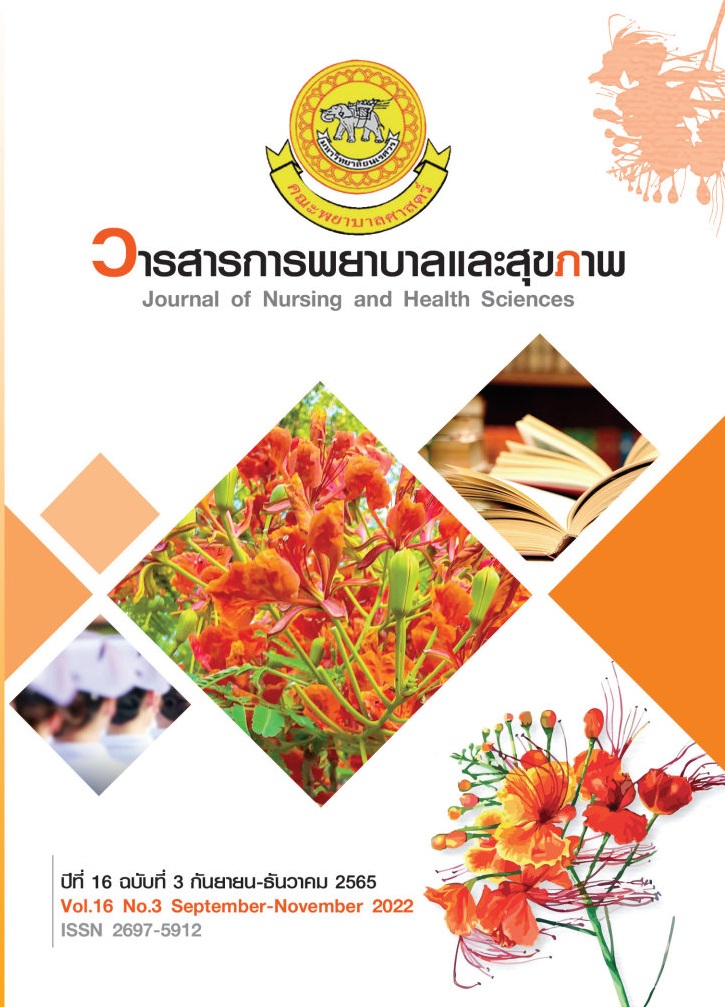Factors Correlated with 21st Century Learning Skills of Nursing Students, Naresuan University
Main Article Content
Abstract
The objectives of this descriptive correlational research were to study 1) the factors of learner, instructor, teaching and learning management, and supporting and 2) the 21st century learning skills reported by nursing student, and 3) determine the relationship between those factors and the 21st century learning skills of nursing students, Naresuan University. The study sample was composed of 159 nursing students in the 3rd and 4th year levels in the academic year 2021. The research instruments were the questionnaires of the factors; learners, instructors, teaching and learning management, and supporting, and the 21st century learning skills. The content validity indexes of the questionnaires were 1.0, 0.97, 1.0, 1.0 and .99, respectively. The Cronbach’s alpha coefficients of the questionnaires were .83, .92, .93, .91 and .93, respectively. Data were analyzed by descriptive statistics and Spearman rank correlation coefficient.
The result revealed that the overall 21st century learning skills of nursing students were at the high level ( = 4.16, S.D. = .40). The nursing students reported the high level of all factors; learner, instructor, teaching and learning management, and supporting ( = 4.21, S.D. = .46, = 4.16, S.D. = 4.9, = 4.11, S.D. = .48 and = 3.96, S.D. = .59, respectively). All the factors had positive relationship and statistically significant (p < .001) with 21st century learning skills of nursing students. The learner factor had high relationship (r = .73), and instructor, teaching and learning management, and supporting factors had moderate relationship (r = .62, .61 and .57, respectively).
Article Details

This work is licensed under a Creative Commons Attribution-NonCommercial-NoDerivatives 4.0 International License.
References
Armpat, C., Pisaipan, P., Tarmong, C., Suwannarat,
K., Netgrajang, C., & Chonlatankampana, W.
(2018). Factors correlated with perception
toward 21st century learning skills among
nursing students, PhrapokklaoNursing
College. Journal of PhrapokklaoNursing
College. 29(2), 36-46. [In Thai].
Chooha, U., Somchoe, P., Naksukhum, S.,
Poungsarmai, P., Prayoonsirisak, R.,
& Mongkolsawad, J. (2019). How to produce
nursing to meet the needs of graduate user
in the 21st century: Challenges of Thai nurs
ing instructors. Mahasarakham Hospital
Journal, 16(2), 176-186. [In Thai] .
Faculty of Nursing, Naresuan University. (2021).
Self-assessment report, Bachelor of nursing
program. Faculty of nursing, Naresuan
university. [In Thai].
Kaewmanee, C. (2019). 21st Century skills of the
undergraduates Boromarajonani College of
Nursing Sunpasitthiprasong.
Journal of Health Sciences of Boromarajon
naniCollege of Nursing, Sunpasitthiprasong,
(3),11-27. [In Thai]
Ministry of Education. (2017). National education
plan 2017-2036. Bangkok: Prigwhan Graphic.
[In Thai].
Panich, V. (2012). The way to create learning in
the 21st century. Bangkok: Sodsrisaritwong
Foundation. [In Thai].
Partnership for 21st CenturyLearning (P21): A
Network of Battelle for Kids. (2019). Frame
work for 21st century learning
definitions. Retrieved 6 April 2021 from
https://static.battelleforkids.org/documents/
p21/P21_Framework_Brief.pdf
Pengpit, P., Sukjairungwattana, T., & Chantaranam
choo, N. (2020). The factors relations the
st century skills of undergraduate student's
Kasetsart University KamphaengSaen
campus. Journal of Education Silpakorn
University. 18(1), 319-338. [In Thai].
Petchkong, J. (2016). Causal factors affecting to
learning outcome of nursing students:
Boromarajonani College Nursing, Chakriraj.
Earthen Asia University Heritage Journal
Science and Technology, 10(2), 199-211.
[In Thai].
Saraketrin, A., Rongmuang, D., & Chantra, R. (2019).
Nursing education in the 21st Century:
competencies and roles of nursing instructors.
Journal of the Royal Thai Army Nurses, 20(1),
-20. [In Thai].
Srisatidnarakul, B. (2010). The methodology in
nursing research. Bangkok: U & I Inter
Media. [In Thai]
Sroysing, K. (2020). Factors affecting learning and
innovation skills in the 21st century of the
students at the Dusit Thani
College. Dusit Thani College Journal. 14(2),
-501. [In Thai].
Suwannakeeree, W., Jullmusi, O., Boonpracom, R.,
& Wongwiggan, S. (2022). Nursing teaching
and learning management during the
Coronavirus Disease 2019 pandemic: A case
study of the Faculty of Nursing, Naresuan
University. Journal of Nursing and Health
Sciences, 16(2), 1-13. [In Thai].
Suwannakeeree, W., Suwannaosod, S., Chairat,
R.,Chaiem, O., & Tongsaard, T. (2019).
Exploring 21st Century Learning Skills of
Nursing Students, Naresuan University.
Journal of Nursing and Health Sciences,
(1), 89-98. [In Thai].
Sriprom, C., Rungswang, A., Sukwitthayakul, C.,
& Chansri, N. (2019). Personality traits of
Thai Gen Z undergraduates: Challenges in
the EFL classroom. PASAA, 57, 165-190.
Yamane, T. (1973). Statistics: An introduction
analysis (2nd ed.). New York: Harper & Row.


